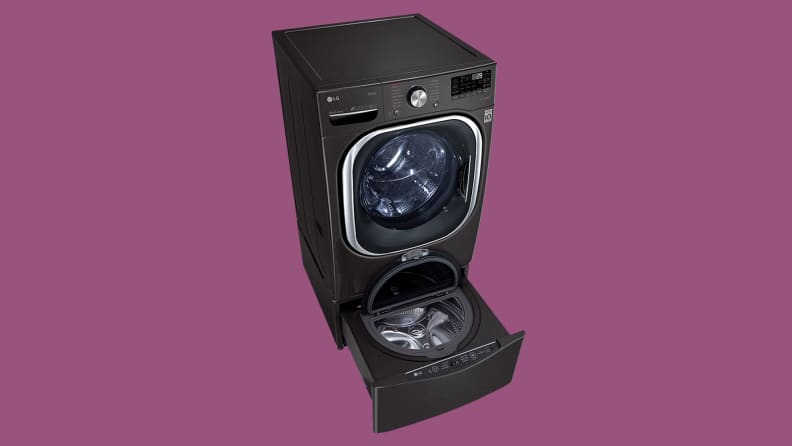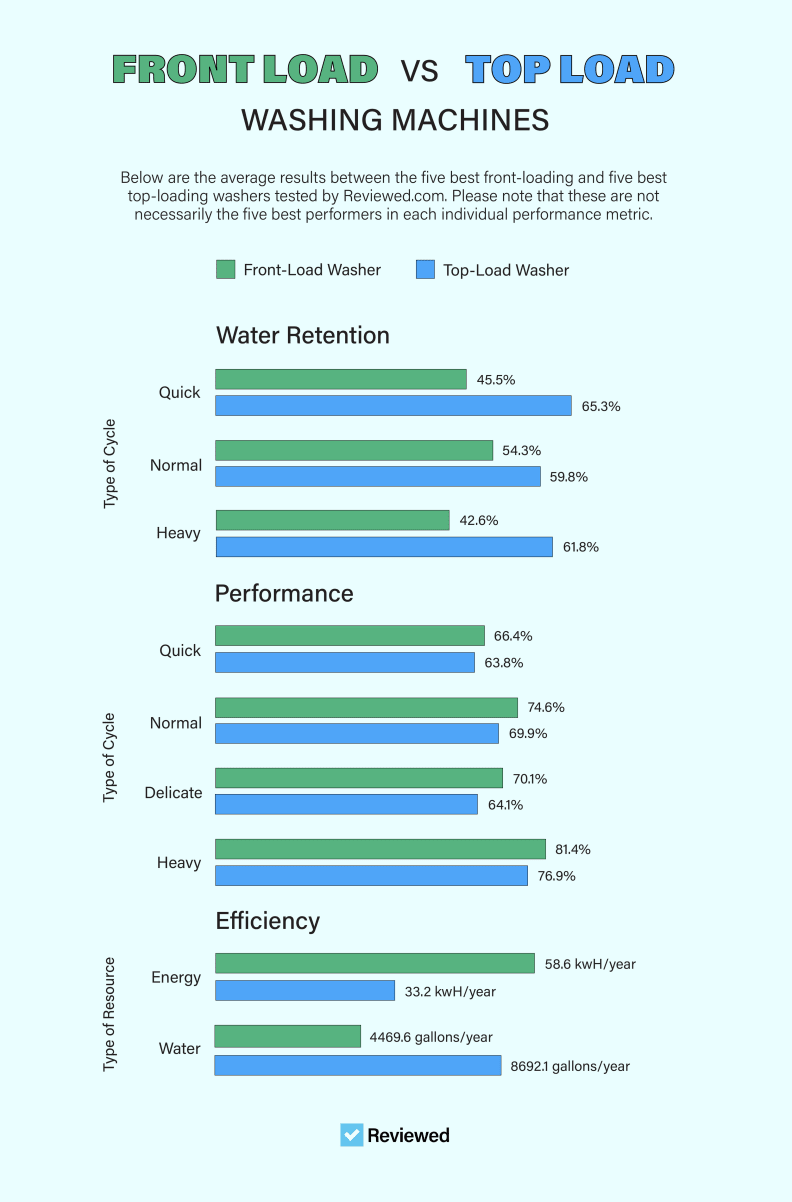Front load vs. top load washer: What's best for you?
For most people, there's a clear winner
 Credit:
Maytag, Miele
Credit:
Maytag, Miele
Recommendations are independently chosen by Reviewed's editors. Purchases made through the links below may earn us and our publishing partners a commission. Prices were accurate at the time this article was published but may change over time.
One of the deepest debates in the large appliance game, and the washing machine market more specifically, is: front-loaders vs. top-loaders. As in, which cleans the best?
If you spend any time at all reading washing machine user reviews, you’ll note many livid individuals complaining that their new modern front-loader is too small, ineffective, can’t move clothes around without an agitator, and uses nowhere near enough water. On the other hand, their 30-year-old top-loader they just replaced was perfect.
While modern washers, both front-loading and top-loading, have very different designs, strengths, and weaknesses compared to their forebears, despite these appearances they’re actually doing a much better job in terms of cleaning and energy efficiency—especially front-loaders.
In order to understand how front-loaders can simultaneously seem so weak and ineffective, but still put up consistently better numbers than their top-loading counterparts, we’ll dig into the controversy.
Top-load washers: The former champion
Let’s start with the old-school design that all modern washers are invariably compared against: the top-loader with a pole agitator.
Older top-loaders were known for two things: a central pole used to agitate the laundry and their tendency to fill up the washing drum with water. Modern top-loaders use an impeller and use less water—for good reason.
The issue with the older implementation of pole agitators is, while they did create a powerful scrubbing motion, that motion was better at exacerbating wear and tear on your clothing than actually scrubbing out stains.
Because the pole takes up the center of the drum, clothes can only rotate around the pole, clockwise or counterclockwise. Impeller-based washers that lack the pole can tumble clothes throughout the drum, providing a fuller range of motion for a deeper and more gentle cleaning.
Modern top-loaders with pole agitators have been designed to not be so rough on clothes, which has led to many actually being more gentle than front-loaders on this metric. Unfortunately, this reduced mechanical action also means reduced stain-scrubbing force. Older top-loaders can fight stains almost as well as modern front-loaders, but can wear out your clothes up to twice as fast, according to our data.
Older top-loaders used to fill up with a lot of water, which has led to a lasting lineage of consumers who swear by high water lines. Many modern top-loaders still have “Extra Fill” features to this day. However, more water doesn’t equate to cleaner clothes, as counterintuitive as that may seem. Too much water will actually dilute the detergent. While it might make sense to use extra water if your clothes are absolutely caked in mud, in every other case adding more water results in dirtier laundry.
Front-load washers: The relative newcomer (that had a rocky start)

If you don't want to stoop to front-load your laundry, most have optional pedestal—some of which have a smaller washing chamber inside them.
Front-load washing machines had a rocky start. The earliest iterations cost significantly more than traditional top-loaders, weren’t as reliable or as user-friendly, and needed the door to be left open after a cycle as their internal gaskets were magnets for mildew.
Over time, manufacturers have tackled front-loaders’ myriad design flaws to the point where, at present, a front-loader is the best option by just about every metric. They’re better at scrubbing out stains, easier to load (especially when used with a pedestal), and use less water and electricity than modern top-loaders.
The reason they’re better at scrubbing out stains is due to the lack of an agitator and the tumbling motion they can achieve from their horizontal orientation. A top-loader with a pole agitator provides less range of motion than a top-loader with an impeller, while a front-loader’s tumbling motion provides the most range of motion, allowing clothes to jostle up against each other along more axes. This motion is also far more gentle than the twisting and pulling you’d get from a pole agitator.
Front-loaders can also be easier to load physically, as they don’t require clothes to be lifted up and over the top of the machine. While their shorter stature may require users to stoop down to load them, almost every front-loader can come outfitted with a pedestal to boost up its height, allowing users to load laundry from a more comfortable position.
Regarding resource usage, front-loaders maintain their efficiency largely due to some clever leveraging of gravity. Because the clothes are getting picked up by paddles mounted to the drum, then allowed to fall back down again, the machine doesn’t have to work as hard.
Top-load agitators, on the other hand, need to both push and pull on clothes or else they won’t move anywhere. This tumbling motion also necessitates using less water, as the tumbling requires clothes to be picked up out of the water before being gently folded back into the mixture. The result: Front-loaders yield lower utility bills than top-loaders.
The take-away: Most people should buy a modern front-loader

In our labs at Reviewed, we’ve tested hundreds of washing machines. Our data shows that front-loaders are more efficient when it comes to cleaning performance, water retention, efficiency, and cost to run per year. Top-loaders win for clothes wear and tear, which really isn’t a win since it means you’ll have to replace your clothes more often.
The one scenario where you’d want to consider a top-load washing machine over a front-load washing machine is if your clothes get excessively dirty all of the time. For example, if you work on a farm, or in the mining industry—any job where it wouldn’t seem crazy to hose down your laundry before putting it in the washer.
The product experts at Reviewed have all your shopping needs covered. Follow Reviewed on Facebook, Twitter, Instagram, TikTok, or Flipboard for the latest deals, product reviews, and more.
Prices were accurate at the time this article was published but may change over time.




